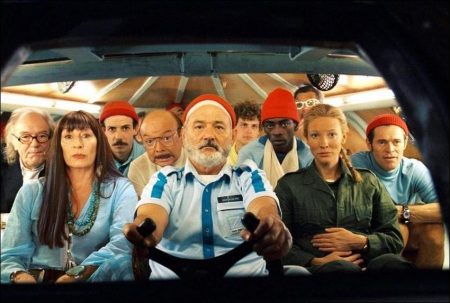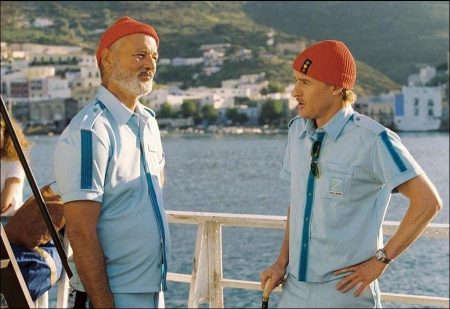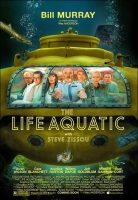“We’re all a pack of strays – don’t you get it?” – Steve Zissou
The Life Aquatic with Steve Zissou. In his fourth and most ambitious film to date, director Wes Anderson sets out on a high-seas adventure comedy, spinning the tale of a washed-up oceanographer (Academy Award nominee Bill Murray) in search of love, revenge and a drop of redemption in his ultimate aquatic quest. Plying the waters as only Anderson could, The Life Aquatic with Steve Zissou embarks on a journey into a realm of pirates, islands and deadly jaguar sharks-and into a maelstrom of human yearning set adrift.
Meet Steve Zissou: legendary underwater explorer, notorious blow-hard, and a man known around the globe for his documentaries about the teeming life beneath the deep blue sea. These days, however, life on land isn’t going so smoothly for Zissou. His best friend and long-time partner, Esteban, was recently consumed by a ravenous jaguar shark.
Rumors are starting to spread that he’s losing his touch. And now, out of the blue, comes a genuine Southern gentleman and Air Kentucky co-pilot named Ned Plimpton (Owen Wilson) who claims he might, or might not, be the long-lost son Steve never got to know. Imperious, egotistical and endearingly off-course, Steve Zissou is now ready to make his most epic film to date-the one in which he will wage vengeance on the jaguar shark, become the father he never thought he could be, and regain some fleeting sense of his own nobility.
About the Screenplay
“You’re supposed to be my son, right?”
“I don’t know, but I did want to meet you, just in case.”
With just three films-“Bottle Rocket,” “Rushmore” and “The Royal Tenenbaums”-Wes Anderson has established a comically charged yet deeply human view of modern life and relationships. Each of his broadly appealing comedies has tackled recurring themes of aspiration, misfits, family, love and the fall from grace. His fourth film takes these same themes into wholly new territory as Anderson simultaneously tackles an ocean-going adventure rife with chases, shoot-outs, preying sharks and underwater wonders.
In a sense, The Life Aquatic became Anderson’s own expedition into the unknown. Barry Mendel explains: “Wes took some wild risks in making this movie. He essentially threw out the `Wes Anderson book’ and reinvented himself. Far from the very precise chamber pieces of `Rushmore’ or `The Royal Tenenbaums,’ he’s thrown himself into a chaotic, exterior, fantastical genre film.”
Anderson’s novel-like screenplays always emerge from intimate personal experience and at the center of The Life Aquatic is another character close to Anderson’s heart: Steve Zissou, a world-famous oceanographer who is both comically familiar and entirely unique. Long fascinated by aquatic films and undersea life in general, Anderson had always wanted to make a movie set on a boat in the world of adventure filmmaking. “This is a movie I’ve been thinking about for fourteen years,” he comments. “I’ve always been fascinated by this strange and amazing character who creates a kind of eccentric family at sea.”
As early as his college years, Anderson penned a short story about an oceanographer that introduced Steve Zissou, his boat The Belafonte and the wife who turns out to be the real brains behind his operation. From there, the character continued to evolve over the years, as Anderson continued to ponder the personality and plight of Steve Zissou and at last began to collaborate on a screenplay with his long-time friend Noah Baumbach, a writer and director (“Kicking and Screaming”) who also writes comic pieces for The New Yorker. Meeting at the same New York restaurant day after day, Anderson and Baumbach fleshed out the story not only of Zissou, but also of his crew of fellow dreamers who set out to sea with him. As they wrote the action-packed story of Team Zissou, their explorations of the characters brought the story’s undercurrents to the surface.
“Steve Zissou is someone whose entire modus operandi in life is to create a team, to always be surrounded by a group of people who will go with him on his adventures,” explains Anderson. “But now he’s reached a point in his life where he’s already done a lot of his work, where he’s been married a couple of times, and suddenly, it all seems to be slipping away.”
“So the story is about Steve Zissou, this band of adventurers that he brings together and the mission that they go on in search of a creature that may or may not exist. And, at the same time, it’s about a guy who is at a low point in his career and is trying to reach for something greater than he’s ever done before-to reaffirm himself. And when he meets somebody who might be his son, that suddenly brings him back in touch with some things he’s lost contact with, as well as questions he hasn’t asked himself in a long time, and changes the whole journey.”
The screenplay went beyond anything Anderson had previously done in terms of inventing an entire world that follows its own slightly off-kilter rules of reality. When producer Barry Mendel read an early draft of The Life Aquatic, he was quickly drawn into the totally enveloping fictional world Anderson and Baumbach had created.
“The level of detail and the amount of emotional layers and the sophistication of the dialogue in that first draft was terrific,” says Mendel. “Wes’s verbal dexterity and ability to shift cadences and ideas in a heartbeat is something that doesn’t really exist outside of his movies. It’s something that I think people almost take for granted in a Wes Anderson movie-that the dialogue will be brilliant-but he takes it to the next level in this film with lines that are constantly funny, revealing and memorable.”
Continues Mendel, “The screenplay really reflects the amount of fun that Wes and Noah had writing it. It takes you into a completely rambunctious, alive and energetic world filled with wonderful characters.”
The script ultimately brought to life not only Steve Zissou’s subtle personal transformation as he approaches fatherhood and posterity but an imaginative, whimsical undersea world even more eccentric, mercurial and magical than the real thing. “In the film, we wanted to show the way Steve Zissou sees this underwater world that he loves, that has so much magic and surprise to him, that draws him into a whole other reality,” explains Anderson.
“I mean, we’re now all so used to seeing amazing underwater photography from flipping through the cable channels and we knew we couldn’t compete with that. So we went the opposite route, trying to rely almost entirely on our imaginations. So as Noah and I were writing, we would be thinking about what creatures the team would come across, and we might start with just a stingray, but then we would say, how about a stingray with constellations on it that are glowing-and it developed from there.”
From the beginning, Wes Anderson decided that rather than create this world with lavish, high-tech digital technology, he’d go back in time instead, to some of filmmaking’s oldest and most classic techniques of forging creatures, emphasizing the pure pleasures of stop-motion animation.
“I wanted a handmade look to the film,” he says. “There’s a real personality to these old techniques and there’s a feeling of craft that’s very different from what you get when you do things digitally. I’ve always admired Henry Selick’s work and I knew he would bring a great deal of artistry to the film. It just has the right quality for this story. I couldn’t imagine going too high-tech to tell the story of Team Zissou and their adventures on The Belafonte.”
Barry Mendel comments, “It was a completely bold concept to make a movie about an oceanographer with completely fake fish. We knew nothing like it had ever been done. But I think Wes was also very savvy in immediately recognizing that the undersea world has been captured so magnificently by filmmakers already that he needed to come up with a completely different idea. He creates a unique undersea world in the same way he created a unique New York-ish city for `The Royal Tenenbaums.’ It’s fun to realize that all of the creatures and coral reefs in the film are entirely invented for the film and brought to life with the help of great designers, construction people, painters and a whole stop-motion animation unit that has put together something that is from the human imagination.”
Anderson’s risk-taking continued in the film’s casting as he looked for actors willing to break entirely away from any preconceived molds-casting Bill Murray in his most wide-ranging and emotionally vulnerable role yet; asking Owen Wilson to make a 180-turn from his laid-back, irony-driven characters to take a completely opposite role; having the typically intense Willem Dafoe try a pure comedic role; plucking world-class actor Michael Gambon from the stage to play fading impresario Oseary Drakoulias; and allowing Brazilian actor Seu Jorge (“City of God”) to blossom in unforeseen directions in the musical role of Pele Dos Santos.
The Life Aquatic with Steve Zissou
Directed by: Wes Anderson
Starring: Bill Murray, Cate Blanchett, Owen Wilson, Anjelica Huston, Willem Dafoe, Michael Gambon, Noah Taylor, Jeff Goldblum, Pawel Wdowczak, Matthew Gray Gubler
Screenplay by: Wes Anderson & Noah Baumbach
Production Design by: Mark Friedberg
Cinematography by: Robert Yeoman
Film Editing by: David Moritz
Costume Design by: Milena Canonero
Set Decoration by: Gretchen Rau
Art Direction by: Stefano Maria Ortolani, Marco Trentini, Eugenio Ulissi
Music by: Mark Mothersbaugh
MPAA Rating: R for language, some drug use, violence and partial nudity.
Distributed by: Buena Vista Pictures
Release Date: December 25, 2004
Views: 85





